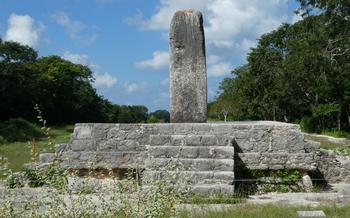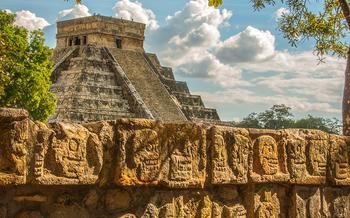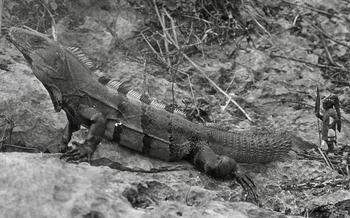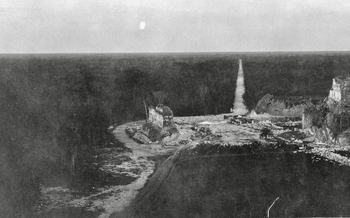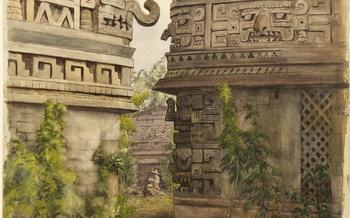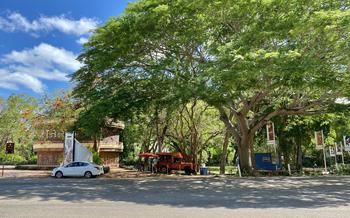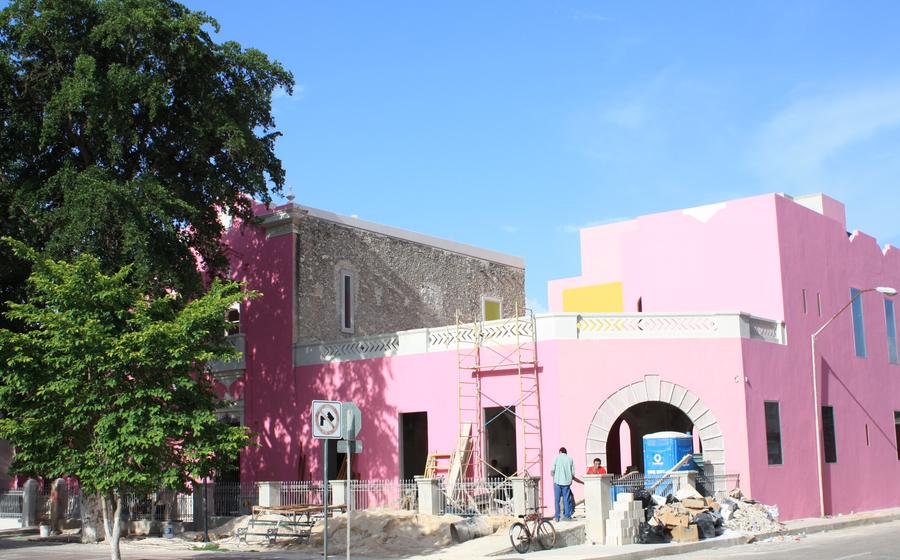
Cenote Dzitnup
- Cenote Dzitnup: A Hidden Gem in Merida
- Getting to Cenote Dzitnup
- Entrance Fees and Hours of Operation
- What to Bring
- Swimming and Snorkeling
- Taking Photos and Videos
- Relaxing and Sunbathing
- Food and Drinks
- Local Guides and Tours
- Cultural Significance
- Nearby Attractions
- Insider Tip
Cenote Dzitnup: A Hidden Gem in Merida
Cenotes are natural swimming holes or sinkholes formed by the collapse of limestone bedrock, revealing groundwater underneath. These stunning natural wonders are a hallmark of the Yucatán Peninsula, which is home to thousands of cenotes, each with its unique charm and characteristics.
Cenote Dzitnup is one such hidden gem located just a short drive from the city of Mérida, the capital of Yucatán. This cenote is part of a private hacienda and is surrounded by lush vegetation, creating a tranquil and serene atmosphere. Dzitnup is a relatively small cenote, but it offers a variety of features that make it a popular destination for swimming, snorkeling, and relaxation.
The history and significance of Cenote Dzitnup are not well documented, but it is believed to have been used by the ancient Maya for ceremonial purposes. The Maya revered cenotes as sacred places, considering them to be gateways to the underworld and a source of life-giving water. Today, Cenote Dzitnup continues to hold cultural and spiritual significance for the local community, who often visit the cenote to pray and make offerings.
Getting to Cenote Dzitnup
To get to Cenote Dzitnup, you have several transportation options available. If you're staying in Merida, the most convenient way to reach the cenote is by taking a taxi or renting a car. The journey takes approximately 45 minutes and costs around 500-600 Mexican pesos one way. Alternatively, you can take a public bus from Merida's main bus terminal to the town of Xcanatún, which is about 10 kilometers from the cenote. From Xcanatún, you can catch a local taxi or tuk-tuk to complete the journey.
If you choose to drive yourself, take the following route: head north on Calle 60 from Merida and continue for approximately 30 kilometers. Turn left onto Calle 20 and follow it for another 10 kilometers. Finally, turn right onto Calle 17 and follow the signs to Cenote Dzitnup. Once you arrive, you'll find ample parking space available on-site.
Entrance Fees and Hours of Operation
Cost of Admission
Cenote Dzitnup charges a modest entrance fee for visitors. The exact amount may vary, so it's advisable to check the latest rates before your visit. However, you can expect to pay around 100-150 pesos (approximately $5-7 USD) for adults and 50-75 pesos ($50-75 USD) for children.
Operating Hours
The cenote is open to the public daily from 9:00 AM to 5:00 PM. However, it's worth noting that the best time to visit is during the morning hours when the sun's rays create a magical play of light and shadows within the cenote.
Special Discounts or Promotions
Keep an eye out for special discounts or promotions offered by the cenote management or local tourism boards. There may be reduced rates for students, seniors, or families, as well as package deals that combine cenote visits with other attractions in the area.
What to Bring
Essential Items
When visiting Cenote Dzitnup, it's crucial to pack the following essential items:
-
Swimsuit: An appropriate and comfortable swimsuit is a must for taking a dip in the refreshing waters of the cenote.
-
Towel: A towel is essential for drying off after swimming or sunbathing. Consider bringing a large, absorbent towel to ensure you stay comfortable.
-
Water shoes: Water shoes or sandals with good grip are recommended for navigating the slippery surfaces around the cenote, particularly when entering and exiting the water.
-
Sunscreen: Protect your skin from the intense tropical sun by applying sunscreen with a high SPF (30 or higher) before and during your visit.
-
Hat and sunglasses: A hat and sunglasses provide additional protection from the sun's harmful UV rays.
-
Cash: Although some cenotes may accept credit cards, it's advisable to carry cash for entrance fees, local vendors, or other unforeseen expenses.
Optional Items
For a more enjoyable and enriching experience, consider bringing these optional items:
-
Snorkeling gear: Snorkeling equipment allows you to explore the underwater world of the cenote, teeming with diverse marine life. If you don't have your own gear, you can rent it on-site or bring your own.
-
Underwater camera: Capture the stunning underwater scenery and marine life with an underwater camera or a waterproof case for your smartphone.
-
Dry bag: A dry bag is useful for keeping your belongings, such as electronics and valuables, safe and dry while you swim or explore the cenote.
Things to Avoid Bringing
To ensure the preservation of the cenote's natural beauty and ecosystem, avoid bringing the following items:
-
Non-biodegradable sunscreen: Opt for eco-friendly and biodegradable sunscreen to minimize your impact on the environment.
-
Food and drinks: Consuming food and beverages is prohibited in the cenote to prevent pollution and maintain water quality.
-
Alcohol: Alcohol consumption is not permitted within the cenote premises for safety reasons.
-
Pets: Pets are generally not allowed in cenotes to prevent contamination and ensure the safety of both animals and visitors.
Swimming and Snorkeling
The crystal-clear waters of Cenote Dzitnup offer exceptional visibility, making it an ideal spot for swimming and snorkeling. Immerse yourself in the refreshing depths and discover a vibrant underwater world teeming with marine life. Schools of colorful fish dart through the water, while turtles and other aquatic creatures glide gracefully by.
For those who wish to explore the cenote's hidden depths, snorkeling is a must. Rental equipment is available on-site, allowing you to get up close and personal with the diverse underwater ecosystem. Observe the intricate coral formations, home to a myriad of marine organisms. The cenote's unique underwater topography creates a mesmerizing spectacle, with shafts of sunlight filtering through the water, illuminating the vibrant colors of the coral and fish.
Taking Photos and Videos
Cenote Dzitnup is a visual paradise, and capturing its beauty through photos and videos is a must. The crystal-clear waters offer excellent visibility, allowing you to showcase the vibrant underwater world. For stunning shots, position yourself against the sun's rays, creating a magical play of light and shadow.
When taking underwater photos and videos, consider using a waterproof camera or a housing for your device. This will protect your equipment from damage while allowing you to capture stunning close-ups of the marine life. Experiment with different angles and perspectives to create unique and captivating content.
For those looking to document their swimming or snorkeling adventures, GoPro cameras or similar action cameras are ideal. These compact devices can be mounted on your head or gear, providing a first-person perspective of your underwater explorations.
Relaxing and Sunbathing
The Cenote Dzitnup offers a tranquil setting for relaxation and sunbathing. Designated areas with soft sand or grassy patches provide comfortable spots to soak up the sun's warmth. Natural shade is limited, but you can find respite under the shade of tall trees or take advantage of the sun loungers or chairs available for rent. The serene atmosphere and the gentle sounds of nature create a perfect ambiance for unwinding and recharging.
Food and Drinks
Cenote Dzitnup offers a small on-site restaurant serving a variety of local and international dishes, including fresh seafood, traditional Mayan cuisine, and refreshing beverages. Visitors can enjoy their meals at tables set up in the shade of the surrounding trees, creating a delightful and immersive dining experience.
Picnics and BYOB: For those who prefer a more personalized dining experience, Cenote Dzitnup allows visitors to bring their own food and drinks. Designated picnic areas with tables and benches are available for guests to set up their own feast. Please note that glass containers are not permitted for safety reasons.
Nearby Restaurants and Cafés: If you're looking for a wider variety of dining options, there are several restaurants and cafés located within a short drive from the cenote. These establishments offer a range of cuisines, from traditional Mexican fare to international delights, ensuring that there's something to satisfy every palate.
Local Guides and Tours
Hiring a local guide is highly recommended for those who want to get the most out of their visit to Cenote Dzitnup. These experienced guides can provide valuable insights into the history, geology, and ecology of the cenote, as well as share fascinating stories and legends passed down through generations. They can also lead you to hidden spots within the cenote that you might not find on your own.
Guided tours typically last for about an hour and include a walk around the cenote, a swim in the refreshing waters, and a visit to the nearby caves. Prices for guided tours vary depending on the size of the group and the length of the tour. Most guides speak English and Spanish, but it's always a good idea to confirm beforehand if you have any specific language preferences.
Whether you choose to explore Cenote Dzitnup on your own or with a guide, it's sure to be a memorable and enriching experience.
Cultural Significance
Cenotes were sacred places for the ancient Maya, who believed they were gateways to the underworld and the realm of the gods. They used cenotes for religious ceremonies, rituals, and sacrifices. According to Maya mythology, the cenotes were created by the gods to provide drinking water for the people during a great drought.
Cenote Dzitnup is particularly significant because it was once a sacred place for the Maya to perform religious rituals. Maya people believed that the cenote was a portal to the underworld, where they could communicate with their ancestors and deities. Offerings were made to the gods in the form of precious objects, such as jade, gold, and pottery, which have been discovered by archaeologists during excavations.
To this day, Cenote Dzitnup remains a place of cultural and spiritual significance for the Maya people. It is still used for traditional ceremonies and rituals, and many Maya believe that the cenote possesses healing powers.
Nearby Attractions
Beyond the allure of Cenote Dzitnup, the surrounding area offers a plethora of additional attractions that beckon the adventurous traveler. A constellation of otherworldly cenotes lies scattered throughout the region, each boasting its own unique charm and characteristics. Cenote X'keken, with its crystal-clear waters and otherworldly rock formations, is a must-see for cenote enthusiasts. For those seeking a glimpse into the past, the ancient Maya ruins of Dzibilchaltun and Mayapán stand as testaments to the region's rich history and cultural heritage. These archaeological sites offer a fascinating glimpse into the lives and customs of the ancient Maya civilization.
Venturing beyond the realm of cenotes and ruins, the colonial towns and villages that dot the landscape invite travelers to immerse themselves in the region's vibrant culture and traditions. Merida, the capital of Yucatán, captivates with its colorful colonial architecture, bustling markets, and delectable cuisine. Valladolid, with its charming cobblestone streets and serene central plaza, offers a glimpse into the region's colonial past. These towns and villages provide a perfect blend of history, culture, and local charm, ensuring a well-rounded and unforgettable travel experience.
Insider Tip
To make the most of your visit to Cenote Dzitnup, aim to arrive early in the morning before the crowds start to gather. This will allow you to enjoy the tranquil ambiance of the cenote and capture stunning photos without distractions. Additionally, the early morning light beautifully illuminates the cenote's crystal-clear waters, creating enchanting reflections and enhancing the overall experience.
Secret Spot: For a truly secluded and magical experience, venture to the far end of the cenote, where you'll discover a hidden chamber adorned with stalactites and stalagmites. This intimate spot is perfect for taking a refreshing dip away from the crowds and connecting with the serene beauty of nature.
